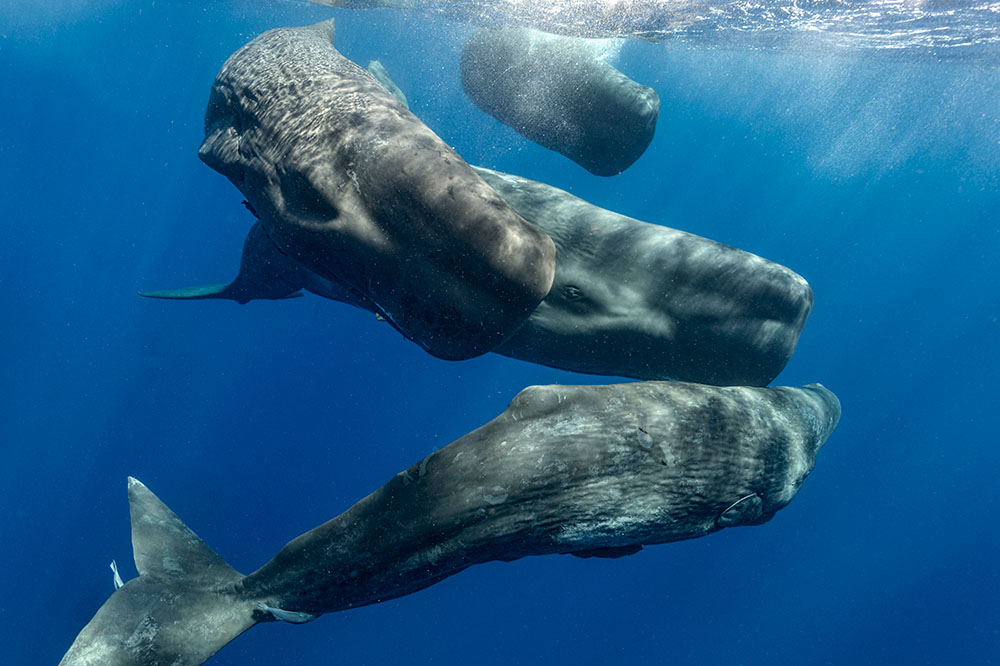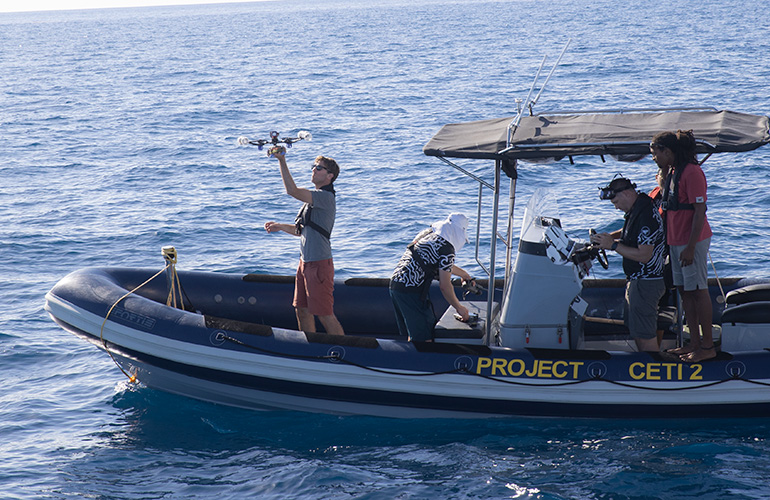|
Listen to this article |

Project CETI is a nonprofit scientific and conservation initiative that aims to decode whale communications. | Source: Project CETI
Off the idyllic shores of Dominica, a country in the Caribbean, hundreds of sperm whales gather deep in the sea. While their communication sounds like a series of clicks and creaks to the human ear, these whales have unique, regional dialects and even accents. A multidisciplinary group of scientists, led by Project CETI, is using soft robotics, machine learning, biology, linguistics, natural language processing, and more to decode their communications.
Founded in 2020, Project CETI, or the Cetacean Translation Initiative, is a nonprofit organization dedicated to listening to and translating the communication systems of sperm whales. The team is using specially created tags that latch onto whales and gather information for the team to decode. Getting these tags to stay on the whales, however, is no easy task.
“One of our core philosophies is we could never break the skin. We can never draw blood. These are just our own, personal guidelines,” David Gruber, the founder and president of Project CETI, told The Robot Report.
“[The tags] have four suction cups on them,” he said. “On one of the suction cups is a heart sensor, so you can get the heart rate of the whale. There’s also three microphones on the front of it, so you hear the whale that it’s on, and you can know the whales that’s around it and in front of it.
“So you’ll be able to know from three different microphones the location of the whales that are speaking around it,” explained Gruber. “There’s a depth sensor in there, so you can actually see when the whale was diving and so you can see the profiles of it going up and down. There’s a temperature sensor. There’s an IMU, and it’s like a gyroscope, so you can know the position of the whale.”
 Learn from Agility Robotics, Amazon, Disney, Teradyne and many more.
Learn from Agility Robotics, Amazon, Disney, Teradyne and many more.
Finding a humane way to tag whales
One of the core principles of Project CETI, according to Gruber, is to use technology to bring people closer to animals.
“There was a quote by Stephen Hawking in a BBC article, in which he posited that the full development of AI and robotics would lead to the extinction of the human race,” Gruber said. “And we thought, ‘This is ridiculous, why would scientists develop something that would lead to our own extinction?’ And it really inspired us to counter this narrative and be like, ‘How can we make robots that are actually very gentle and increase empathy?’”
“In order to deploy those tags onto whales, what we needed was a form of gentle, stable, reversible adhesion,” Alyssa Hernandez, a functional morphologist, entomologist, and biomechanist on the CETI team, told The Robot Report. “So something that can be attached to the whale, where it would go on and remain on the whale for a long amount of time to collect the data, but still be able to release itself eventually, whether naturally by the movements of the whale, or by our own mechanism of sort of releasing the tag itself.”
This is what led the team to explore bio-inspired techniques of adhesion. In particular, the team settled on studying suction cups that are common in marine creatures.
“Suction discs are pretty common in aquatic systems,” said Hernandez. “They show up in multiple groups of organisms, fish, cephalopods, and even aquatic insects. And there are variations often on each of these discs in terms of the morphology of these discs, and what elements these discs have.”
Hernandez was able to draw on her biology background to design suction-cup grippers that would work particularly well on sperm whales that are constantly moving through the water. This means the suction cup would have to withstand changing pressures and forces. They can stay on a whale’s uneven skin even when it’s moving.
“In the early days, when we first started this project, the question was, ‘Would the soft robots even survive in the deep sea?’” said Gruber.
How suction cup shape changes performance
“We often think of suction cups as round, singular material elements, and in biology, that’s not usually the case,” noted Hernandez. “Sometimes these suction disks are sort of elongated or slightly different shaped, and oftentimes they have this sealing rim that helps them keep the suction engaged on rough surfaces.”
Hernandez said the CETI team started off with a standard, circular suction cup. Initially, the researchers tried out multiple materials and combinations of stiff backings and soft rims. Drawing on her biology experience, Hernandez began to experiment with more elongated, ellipse shapes.
“I often saw [elongated grippers] when I was in museums looking at biological specimens or in the literature, so I wanted to look at an ellipse-shaped cup,” Hernandez said. “So I ended up designing one that was a medium-sized ellipse, and then a thinner ellipse as well. Another general design that I saw was more of this teardrop shape, so smaller at one end and wider at the base.”
Hernadez said the team also looked at peanut-shaped grippers. In trying these different shapes, she looked for one that would provide increased resistance over the more traditional circular suction cups.
“We tested [the grippers] on different surfaces of different roughness and different compliance,” recalled Hernandez. “We ended up finding that compared to the standard circle, and variations of ellipses, this medium-sized ellipse performed better under shear conditions.”
She said the teardrop-shaped gripper also performed well in lab testing. These shapes performed better because, unlike a circle, they don’t have a uniform stiffness throughout the cup, allowing them to bend with the whale as it moves.
“Now, I’ve modified [the suction cups] a bit to fit our tag that we currently have,” Hernandez said. “So, I have some versions of those cups that are ready to be deployed on the tags.”

Project CETI uses drones to monitor sperm whale movements and to place the tags on the whales. | Source: Project CETI
Project CETI continues iterating
The Project CETI team is actively deploying its tags using a number of methods, including having biologists press them onto whales using long poles, a method called pole tagging, and using drones to press the tags onto the whales.
Once they’re on the whale, they stay on for anywhere from a few hours to a few days. Once they fall off, the CETI team has a mechanism that allows them to track the tags down and pull all of the gathered data off of them. CETI isn’t interested in making tags that can stay on the whales long-term, because sperm whales can travel long distances in just a few days, and it could hinder their ability to track the tags down once they fall off.
The CETI team said it plans to continue iterating on the suction grippers and trying new ways to gently get crucial data from sperm whales. It’s even looking into tags that would be able to slightly crawl to different positions on the whale to gather information about what the whale is eating, Gruber said. The team is also interested in exploring tags that could recharge themselves.
“We’re always continuing to make things more and more gentle, more and more innovative,” said Gruber. “And putting that theme forward of how can we be almost invisible in this project.”

